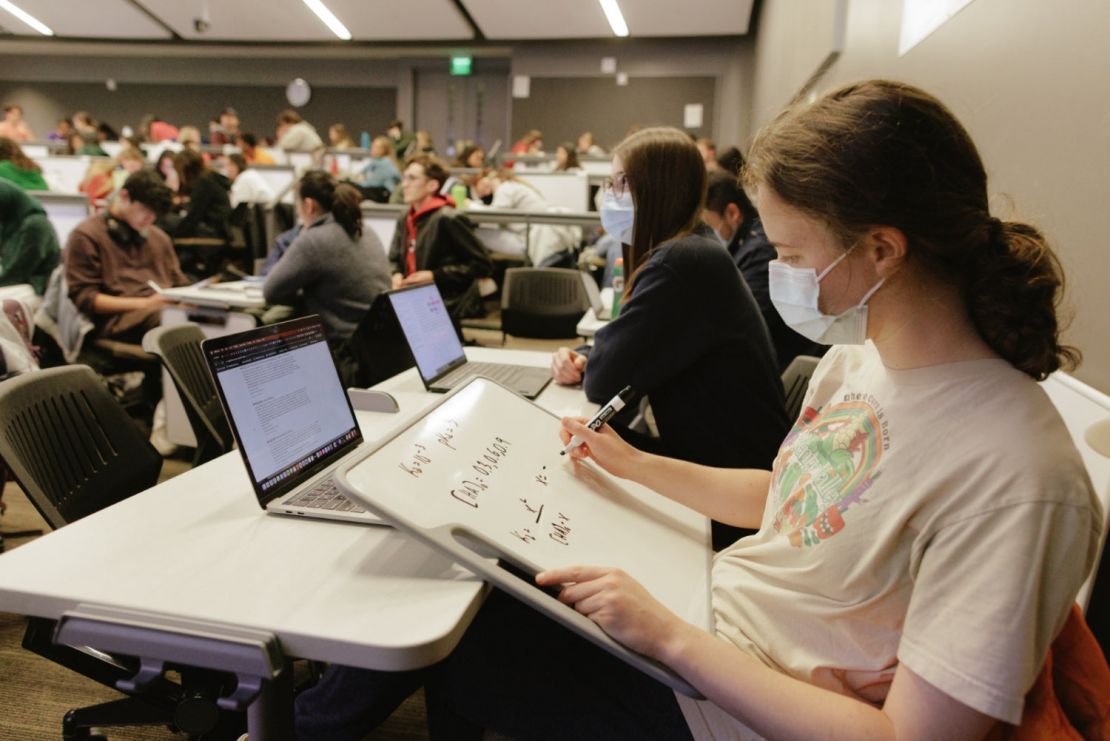Students in Giulio De Leo’s Human and Planetary Health course this fall were able to hear from guest lecturers from around the world – even though many lecturers, concerned about reducing their carbon footprint, would not fly to campus to address the class. De Leo, a professor of oceans, is teaching in a classroom that has been upgraded with a new videoconferencing system as part of a 10-year strategic plan to improve Stanford’s classrooms and informal learning spaces.

To support active learning, dry erase boards are now available in classrooms. (Image credit: Micaela Go)
“It’s been absolutely transformational,” said De Leo, who lives near Stanford’s Hopkins Marine Station, adjacent to the Monterey Bay Aquarium, and commutes to campus when necessary. He has used the videoconferencing technology to teach a class in which some students were at the marine station and some were on campus. “It’s almost like I was there with the students.”
A microphone is embedded in the ceiling, picking up everyone’s voices. When a student asks a question, the camera tracks them.
“I can see who is speaking, which is so much better than having a fixed camera,” De Leo said.
De Leo’s classroom was one of 60 that have been upgraded as part of the Stanford Classrooms Reimagined initiative with user-friendly technology, new furniture, and videoconferencing in most rooms.
A 10-year plan
The Stanford Classrooms Reimagined initiative started in 2019 as a way to develop a master plan for classrooms and informal learning spaces that will meet the changing needs of students and faculty. The team in charge of the initiative conducted an inventory of university classrooms; assessed informal learning spaces such as those near classrooms, in residence halls, in libraries, or other student gathering spots that are designed to extend student learning; and surveyed instructors and students about their needs.
The instructor survey found more interest in active learning. Almost 60 percent of respondents said they had been dissuaded from exploring new teaching methods because of a lack of suitable space.
“There’s no handbook on how to build an inclusive learning space,” said Helen Y. Chu, senior director of learning spaces in Learning Technologies and Spaces, within the Division of Student Affairs. “We are listening to our instructors and students and thinking about what they need to not just have access to a room but to really feel a sense of belonging in that room.”
Flexible classrooms
Classroom improvements include furniture and layouts as well as technology.
One of the goals of Stanford Classrooms Reimagined is that instructors should rarely have to move furniture while setting up for class. To achieve this, instructors can select one of four default layouts: lecture, seminar, small group, or flex chair.
Furniture in upgraded classrooms includes small group tables, which can be used for groups of two, four, or six students. New Flex Chairs swivel to allow students to move quickly from lecture to group work and provide in-seat storage to keep floor space open for active learning. Personal dry erase boards in some classrooms support individual work, group work, and group presentation.
New presentation technology features an intuitive touchscreen interface, improved sound and lighting, a space-saving profile for the equipment stack, and an attached USB-C adapter that supports HDMI connections. Most upgraded classrooms have a new interactive videoconferencing standard that De Leo used.
Positive responses
A pilot test of the new classroom layout received positive reviews from both instructors and students. Half of the instructors and almost two-thirds of the students who responded to a survey said the new layout should be used more often. Students and instructors also said the new Flex Chairs offer increased mobility and versatility and are better for collaborative learning.
“The furniture made the classroom seem more interactive and like a community, giving us the flexibility to move around and encouraging us to engage with our classmates,” said one student who participated in the pilot.

Swivel chairs with built-in desks and places to store backpacks support interactivity and community in class. (Image credit: Micaela Go)
The new chairs have made it easier to change the classroom configuration on the fly. Replacing seminar tables with Flex Chairs has helped foster greater flexibility and collaboration. The flex chairs have an arm attached, are very mobile, and have storage underneath – all in a small footprint.
“I really liked the chairs for the flexibility they gave me for things like group work,” said Christine Alfano, advanced lecturer in the Program in Writing and Rhetoric. “I could reconfigure the room very easily. We don’t all want our students always in rows.”
As with any change, it can take a bit of adjustment, especially for people who are used to walking into a classroom and seeing a seminar table, Alfano said.
“Overall, we’re really happy with the furniture, and are thinking strategically about how to best use it with our writing and speaking classes,” Alfano said.
Future plans
The Stanford Classrooms Reimagined team is spending the academic year evaluating the upgrades that have been completed, supporting the current classrooms, and planning for future upgrades. They will also begin to consider the campus’s informal learning spaces and how they might be upgraded to better support new styles of learning.
“This is a 10-year plan,” Chu said. “It will ultimately touch every university classroom and informal learning space we support on campus.”
